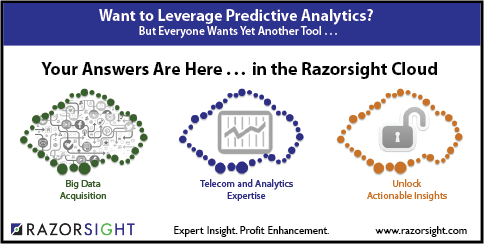Helping CSPs Differentiate via Data Science in the Zettabyte Age
By: Charlie Thomas

The pressures facing communications service providers (CSPs) in the face of exponential data growth, from smartphones and increasingly connected devices to market saturation, declining average revenue per user (ARPU), and new competitors with significant economic advantages, have created a classic case of “Is the glass half full or half empty?”
The market opportunity has never looked better, and CSPs stand to profit handsomely from the mobile explosion and the monetization of “all things connected.” At the same time, the threats have never been greater, with innovative new technologies, including over-the-top (OTT) services and social apps that disrupt traditional telecom and cable models, putting CSPs at risk of being relegated to mere “dumb pipes” in the same way that Uber has upended the taxicab industry’s long-standing service model.
The winners in this new mobile world will be CSPs that quickly jettison old business models and rethink how they serve customers, both in terms of network architecture and a new economic model based on mass personalization. To execute this vision, they’ll need to leverage a major breakthrough in Big Data called predictive analytics, the brainchild of a new generation of data scientists. CSPs that follow this promising new path will redefine the industry and gain a significant competitive advantage in the same way that the Oakland Athletics redefined their 112-year-old “business,” baseball, using rigorous statistical analysis, as documented by journalist Michael Lewis in his 2003 book Moneyball (and the 2011 movie starring Brad Pitt).Recognizing that the classic silo approach to products, markets and customers, not to mention the associated business intelligence (BI) models, is obsolete, CSPs are taking action, embracing a new approach to analytics that looks at those three main areas of interest through a 360-degree lens. These innovators represent a new wave in the telecommunications industry that will dominate the market from 2015 to 2020: by making predictive analytics their number one Big Data priority and capitalizing on new insights into customer wants, consumption and service challenges, they’ll be empowered to swiftly deliver premium services and mass customization on demand.
In the meantime the CSP “all-stars” are preparing for a whole new ball game on a much bigger field, one chalked by the next generation of smartphone and tablet users, who by 2020 will each generate and consume a zettabyte1 of information. Using predictive analytics, the market leaders in telecommunications will step up to the plate with the power to sift through data volumes at a level not previously witnessed.
____________________________
1 A zettabyte is a quantity of information or storage capacity equal to 1,024 exabytes, 1.1 trillion gigabytes or 1 sextillion (1 long-scale trilliard) bytes. As of April 2012, no system had yet stored 1 zettabyte of information; the combined space of all the computer hard drives in the world was estimated at 1,600 exabytes.





















